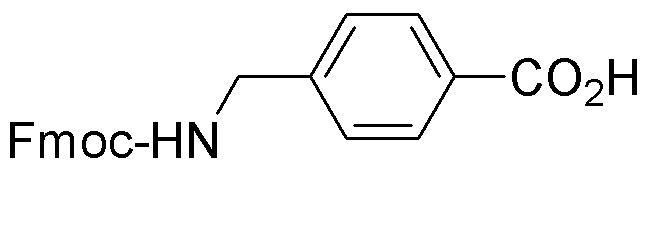Fmoc-(4-aminomethyl) benzoic acid is widely utilized in research focused on:
- Peptide Synthesis: This compound serves as a protecting group in the synthesis of peptides, allowing for selective reactions without interfering with other functional groups. Its stability under various conditions makes it a preferred choice for chemists.
- Drug Development: In pharmaceutical research, it aids in the design of drug candidates by modifying amino acids, enhancing their bioavailability and therapeutic efficacy. This is crucial for developing effective treatments.
- Bioconjugation: The compound is used to attach biomolecules to surfaces or other molecules, facilitating the creation of targeted drug delivery systems and improving the specificity of therapeutic agents.
- Material Science: It finds applications in creating functional materials, such as hydrogels, which can be used in tissue engineering and regenerative medicine, providing scaffolds that mimic natural tissues.
- Analytical Chemistry: Researchers utilize this compound in chromatography and mass spectrometry for the separation and identification of complex mixtures, enhancing the accuracy of analytical methods.
General Information
Properties
Safety and Regulations
Applications
Fmoc-(4-aminomethyl) benzoic acid is widely utilized in research focused on:
- Peptide Synthesis: This compound serves as a protecting group in the synthesis of peptides, allowing for selective reactions without interfering with other functional groups. Its stability under various conditions makes it a preferred choice for chemists.
- Drug Development: In pharmaceutical research, it aids in the design of drug candidates by modifying amino acids, enhancing their bioavailability and therapeutic efficacy. This is crucial for developing effective treatments.
- Bioconjugation: The compound is used to attach biomolecules to surfaces or other molecules, facilitating the creation of targeted drug delivery systems and improving the specificity of therapeutic agents.
- Material Science: It finds applications in creating functional materials, such as hydrogels, which can be used in tissue engineering and regenerative medicine, providing scaffolds that mimic natural tissues.
- Analytical Chemistry: Researchers utilize this compound in chromatography and mass spectrometry for the separation and identification of complex mixtures, enhancing the accuracy of analytical methods.
Documents
Safety Data Sheets (SDS)
The SDS provides comprehensive safety information on handling, storage, and disposal of the product.
Product Specification (PS)
The PS provides a comprehensive breakdown of the product’s properties, including chemical composition, physical state, purity, and storage requirements. It also details acceptable quality ranges and the product's intended applications.
Certificates of Analysis (COA)
Search for Certificates of Analysis (COA) by entering the products Lot Number. Lot and Batch Numbers can be found on a product’s label following the words ‘Lot’ or ‘Batch’.
*Catalog Number
*Lot Number
Certificates Of Origin (COO)
This COO confirms the country where the product was manufactured, and also details the materials and components used in it and whether it is derived from natural, synthetic, or other specific sources. This certificate may be required for customs, trade, and regulatory compliance.
*Catalog Number
*Lot Number
Safety Data Sheets (SDS)
The SDS provides comprehensive safety information on handling, storage, and disposal of the product.
DownloadProduct Specification (PS)
The PS provides a comprehensive breakdown of the product’s properties, including chemical composition, physical state, purity, and storage requirements. It also details acceptable quality ranges and the product's intended applications.
DownloadCertificates of Analysis (COA)
Search for Certificates of Analysis (COA) by entering the products Lot Number. Lot and Batch Numbers can be found on a product’s label following the words ‘Lot’ or ‘Batch’.
*Catalog Number
*Lot Number
Certificates Of Origin (COO)
This COO confirms the country where the product was manufactured, and also details the materials and components used in it and whether it is derived from natural, synthetic, or other specific sources. This certificate may be required for customs, trade, and regulatory compliance.

